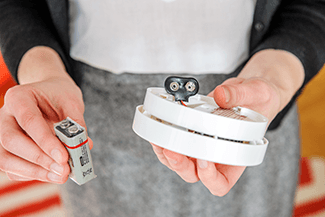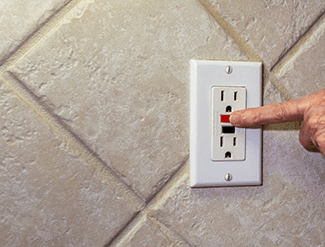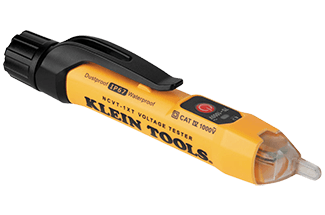We often caution homeowners not to mess with the electrical systems in their homes. There are some electrical repairs and installations that need to be done by a professional, Arizona Registrar of Contractors (ROC)-licensed contractor. However, there are some simple electrical projects that a homeowner can do themselves. Let’s take a look.
Smoke Detectors

Installing smoke detectors might be the most significant DIY task you can undertake concerning the safety and life of your family. Hard wired smoke detector systems should be installed by a licensed electrician, but homeowners can install battery operated units. If you don’t have them, we can’t urge you more emphatically to install them ASAP. These are literally life-saving devices.
The simplest type of smoke detector is battery-operated. Install them on the ceilings outside each bedroom door (unless the doors are adjacent to each other) and just inside the door of each bedroom. Mechanically attaching these life-saving devices to the ceiling is preferred over the “stick on” type. Find the closest ceiling joist and ensure the screw is long enough to bite into the joist. Typically, a 1′ to 1 1/8” wood screw will suffice.
Once installed, check the batteries, and replace them every six months to a year (at most). There is a button on the outside of the smoke detector housing facing the front. When the button is pushed, the alarm will sound if the battery is still functioning. When a battery fails, the smoke detector will emit an annoying chirping sound that doesn’t stop until the battery is replaced or you dismantle it.
We don’t recommend permanently disassembling smoke detectors.
GFCI and ARC Fault Circuits

Homes built in the last 20 years likely have GFCI and ARC fault circuits installed.
The GFCI is designed to detect a surge of current in a circuit, like the kind you might get if you drop a hair dryer into a tub (bad idea, by the way). It shuts off the flow of electricity immediately if something like that were to happen. These devices are on a circuit associated with the outlets by wet areas. There are two little push buttons that say “TEST” and “RESET.” Push the “TEST” button, and the circuit should shut off. Then press the “RESET” button. It should stay in, and the circuit should resume. If the buttons don’t work, meaning they don’t stay in when you push them, then the outlet needs replacing.
If you’re looking to make an upgrade to your outlets, no electrician needed, check out SnapPower on the Rosie Estore!
Always turn off the circuit before you touch any wiring. If you are not sure about the circuit, don’t mess with it. Call an electrician.
The Main Panel
The Service Entry Section, or SES, is where the main panel is located. The power can come from overhead or underground, and the main panel of circuit breakers is generally close by; it may even be attached there. A couple of things to look for here include:
- The age of the panel. If the panel is older than 30 years, make sure it is UL-listed. If it is UL-listed, there will be a sticker somewhere on the panel. If you don’t see a sticker, it is best to hire a professional electrician to give your home’s system a once-over.
- Are the home’s circuits listed clearly at each circuit breaker? Simple words depicting what part of the house that breaker controls are important. Descriptors such as “living room outlets” or “kitchen” are critical for safety. If work is needed, such as replacing a defective GFCI outlet, you must be sure that the correct circuit is shut off. ALWAYS, ALWAYS TEST THE OUTLET BEFORE WORKING ON IT.
-

Voltage testers are cheap and will let you know if an outlet is dead or live! To test an outlet, use a tool called a voltage tester. When plugged into an outlet, it will indicate if there is power. Another way to test an outlet is to use a simple electrical appliance like a hair dryer that will turn on or off with power.
- Turn off one circuit breaker at a time and test all the outlets and light switches to see which ones are not working.
- The ones not working are tied to that particular circuit breaker.
- Once you determine which circuits belong to which outlets, you can then label the main panel using a permanent marker with the room name. This process takes time, but it will be time well spent if you or anyone has to perform electrical work in your home.
Taking care of and testing our electrical systems can be fairly basic and does not require us to delve into touching the wiring systems. Safety is a primary concern we share with all Arizona homeowners all the time, every time! If you are not absolutely certain that you know what you are doing AND NOT ABSOLUTELY SURE THE POWER IS OFF, save the wiring work for a professional. Hire a licensed electrician to help you through any repairs or upgrades.
Stay Safe!
###
PODCAST
We share tips on maintaining your home’s electrical work including how to install an outlet plate with a night light sensor. Joseph of Rosie on the House Certified Thunderbird Plumbing assist 2 homeowners with a mysterious faucet leak and water recirculation pump. Pus, tips on securing double french doors if they swing out and more!
Podcast Archive With Expanded Content and Resources
PHOTO CREDIT
- Klein Tools
- Shutterstock
















